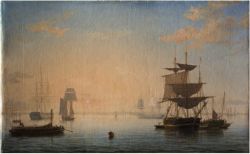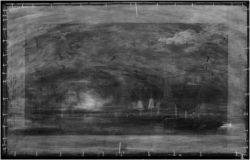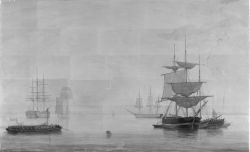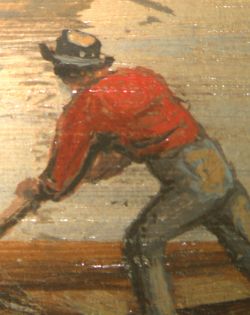loading 
Fitz Henry Lane
HISTORICAL ARCHIVE • CATALOGUE RAISONNÉ • EDUCATIONAL RESOURCE
An online project under the direction of the CAPE ANN MUSEUM
An online project under the direction of the CAPE ANN MUSEUM
Catalog entry
inv. 88
Harbor of Boston, with the City in the Distance
Boston Harbor
c. 1846–47 Oil on canvas 17 x 27 in. (43.2 x 68.6 cm) Signed and inscribed verso (on strainer): FH Lane 16 Tremont Temple
|
Supplementary Images
Provenance (Information known to date; research ongoing.)
the Artist, Gloucester, Mass.
Dr. James H. Armsby, Albany, N.Y., 1847
Joanna Perry Armsby March, sister of J.H. Armsby, Albany, N.Y.
Joanna Armsby March Boyd, Albany, N.Y., by 1864 (by descent from mother)
Alden March Boyd, Santa Barbara, Calif. (by descent from mother)
Joanna March Boyd Bard, Santa Barbara, Calif. (by descent from father)
Henry Travers, Newton, Jr., Joanna Newton Riccardi, and Georgia Newton Pulos (by descent from grandmother)
The Cleveland Museum of Art, Ohio, 2004
Exhibition History
Albany Gallery of Fine Arts, Albany, New York, Second Exhibition, 1847., no. 136.
Palmer's Studio, Albany, New York, Painting and Sculpture Exhibited at Palmer's Studio in Aid of the United States Sanitary Commission, February 22, 1864., no. 2, Boston Harbor.
Santa Barbara Museum of Art, Santa Barbara, California, Santa Barbara Collects, Part One: European and American Art, January 26–March 24, 1985., Boston Harbor.
Published References
Albany Gallery of Fine Arts. Catalogue of the Second Exhibition. Albany, NY: C. Van Benthuysen and Co., 1847., p. 11.
Palmer's Studio. Catalogue of Painting and Sculpture Exhibited at Palmer's Studio, in Aid of the United States Sanitary Commission. Albany, NY: Van Benthuysen's Steam Printing House, 1864., Boston Harbor.
Santa Barbara Collects: A Community Exhibition Celebrating the Reopening of the Santa Barbara Museum of Art. Santa Barbara, CA: Santa Barbara Museum of Art, 1985., ill. p. 32, text, p. 30, Boston Harbor.
Annual Report 2004. Cleveland, OH: The Cleveland Museum of Art, 2005., ills. pp. 9, 14, text pp. 16, 22, Boston Harbor.
Litt, Steven. "Painting's Glow Now Warms Museum." Plain Dealer, July 21, 2004., ill., Boston Harbor.
Adams, Henry. What's American About American Art? A Gallery Tour in the Cleveland Museum of Art. Cleveland, OH: Cleveland Museum of Art, 2008., ill. p. 59, text, pp. 13, 58.
Newton, Travers, and Marcia Steele. "The Series Paintings of Fitz Henry Lane: From Field Sketch to Studio Painting." In Emil Bosshard, Paintings Conservator (1945–2006): Essays by Friends and Colleagues, edited by Maria de Peverelli, Mario Grassi, and Hans-Christoph von Imhoff. Florence: Centro Di, 2009, pp. 194–215., ill., p. 194, text, pp. 200–03, Boston Harbor. ⇒ includes  text
text
H. Travers Newton, Jr. "Fitz Henry Lane's Series Paintings of 'Brace's Rock': Meaning and Technique." Terra Foundation for American Art. Unpublished report., Harbor of Boston, with the City in the Distance. ⇒ includes  text
text








Commentary
Lane’s lithographs, depicting the Boston skyline as background, date back to the mid-1830s (See View in Boston Harbour, c.1836 (inv. 479), Capt. E. G. Austin's Quick Step, "A Yankee Ship and a Yankee Crew", 1837 (inv. 480), and View in Boston Harbour, c.1837 (inv. 605)). Harbor of Boston, with the City in the Distance, painted a decade later, is one of his early views on canvas of that port wherein the skyline plays an integral role, combining atmosphere with the setting sun instead of merely providing static background for a vessel portrait. In this painting, that role is subtle, as the skyline is softened while it blends with mist and clouds at sunset. Contrasts in chroma and value, from foreground to background, coupled with less crowded vessel activity, lend both depth and serenity that make this painting stand apart from Lane’s later Boston Harbor views.
As in many later paintings, Lane depicted Boston as viewed from Governor’s Island, looking west, eight degrees north, to the State House, which is nearly at dead center in the skyline. While the mist-shrouded skyline adds to the serenity of the view, many prominent buildings that might indicate its extent to north and south are too shrouded to identify. This situation is not helped by infrared scans, which indicate that the skyline was not drawn in pencil first, but painted in free-hand, with only a pencil line to indicate sea level at the waterfront.
As with most of Lane’s later harbor scenes, none of the vessels can be identified by name or owner. This view is also unusual for its foreground, dominated by smaller vessel types, while the large merchant ships are relegated to the background. This raises questions regarding Lane’s prospective clientele for this work, and/or his personal reasons for painting it.
The gundalow is of particular interest, being the humblest example of shipbuilding in this view, yet being nearest in the foreground and being a focal point that catches the eye and directs a counterclockwise line of interest around the painting. Human activity is particularly well drawn and purposeful. Infrared scans of the gundalow reveal careful redrawing of the helmsman and one of the oarsmen, suggesting a response to criticism.
Types of depicted vessels are as follows:
– Erik Ronnberg